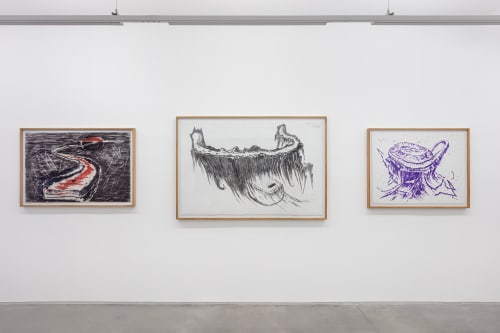MATIAS DUVILLE . CENIZAS DE MAÑANA
Past exhibition
Installation Views
Overview
Casa Triângulo is pleased to present Cenizas de Mañana, Matias Duville’s first solo exhibition at the gallery, with critical essay by Jacopo Crivelli Visconti.
The body of the woman (or of a man – even Matias Duville himself isn’t sure), sitting atop the mountains and observing the sparse procession of approaching boats, is “shot through with the landscape.”[1] In Duville’s artistic universe, human figures are nearly nonexistent, and on the rare occasions they do appear, as in Ciencia Folk (2024), they inhabit “another plane, that’s not exactly there.” The most intriguing aspect of this absence in Duville’s works – whether paintings, drawings, or installations – is the seeming contradiction where his landscapes appear deserted and yet teeming with traces of human presence and activity: felled trees, abandoned objects, and decaying structures. Every element suggests that someone was there and actively participated in the construction of the scene that we can now observe. The artist’s place is also that of a newly arrived observer, who looks at things and describes them. The first impression the viewer gets when encountering these landscapes is that they are forceful and irrefutable critiques from an ecological perspective, a post-apocalyptic world where the worst predictions (all of them, by the way, becoming more plausible every day) have become reality. However, the artist’s relationship with the universe he has been depicting for almost thirty years is more complex than this, and certainly “cannot be reduced to the desire to represent what is happening to the planet.”
Despite changes in style and shifting preferences for drawing, installation and painting at different stages of his career, it seems that the landscape that appears in his works has always been the same. It’s almost as though the observer were watching, over the years, “frames of a film that portrays this landscape.” In this sense, none of the paintings can be considered in total isolation from the others. Likewise, no single work in the exhibition – or, on a larger scale, in Duville’s production as a whole – could ever present a complete portrayal of this landscape. We see what the artist is seeing at that moment, what the camera of his mind is observing. They are fragments, flashes of an “infinite space, almost like the backdrop of a mind, something ungraspable.” The magnitude of the challenge to reproduce a world is reflected in the scale of the works. While in the contemporary art scene it is not unusual to see large-scale installations and paintings, it is quite rare to see drawings made in the large formats that Duville often adopts. The artist considers drawing a more physical medium than painting: “drawing has a lot of the hand in it,” he says, while “painting is more fluid.” Perhaps this fluidity is precisely what makes the works featured in this exhibition visually vibrate in a very different way from most of his drawings, which for their part are nearly always produced in shades of red or black. On the other hand, this same fluidity makes the paintings less physical than the drawings. And this lack of physicality is perhaps what brings about the batterings and impact marks on the surface of the painting, which impart the essence of the hand to the works and make these paintings eminently Duvillian, in the sense that they not only bear the representation of a world we are already familiar with, but also the anguish of a latent, inescapable violence.
When starting a new work, the artist rarely makes studies or preparatory sketches. He usually begins with an idea, a motif of a nearly narrative or even literary nature, “a melting bridge, a frozen wave, a climate that is both cold and tropical...” From there, the scene emerges by a process the author does not completely understand nor fully control. While in his installations, the presence of materials like iron or asphalt presents a familiarity that the work needs to subvert, in his two-dimensional works the observer becomes completely immersed in this parallel universe. Everything is utterly different from what we know, and at the same time intimately familiar. Even the artist sometimes wonders, “Where could this be? I like not recognizing myself, not knowing who made this. When I try to plan what I’m going to do, I usually end up not liking the result.” Despite that over the years he has developed methods and strategies, such as introducing “a little pile of stones, some trees” or other elements that help him “advance over the terrain,” the artist has maintained an undefined position of both creator and observer: “I’m exploring this environment together with the observer; I don’t have control over it.” The idea of a shared exploration of an unknown territory takes us even further away from the reductionist view that sees his work as a critique of the effects of the Anthropocene. Rather, the sensation is that there is a certain ambivalence in the value judgment: catastrophic events for a specific civilization or ecosystem might be irrelevant, or even beneficial, to many others. We are only beginning to explore Matias Duville’s peculiar universe; it’s still too early for us to know what is good and what isn’t, what has unfolded as we might have wished and what has taken other logical paths, based on decisions and whims over which we have no control. For now, we observe. It could be that at some point things will become clearer, or it could be that they will not.
[1] All the quoted phrases are statements by the artist, excerpted from conversations with the author.


